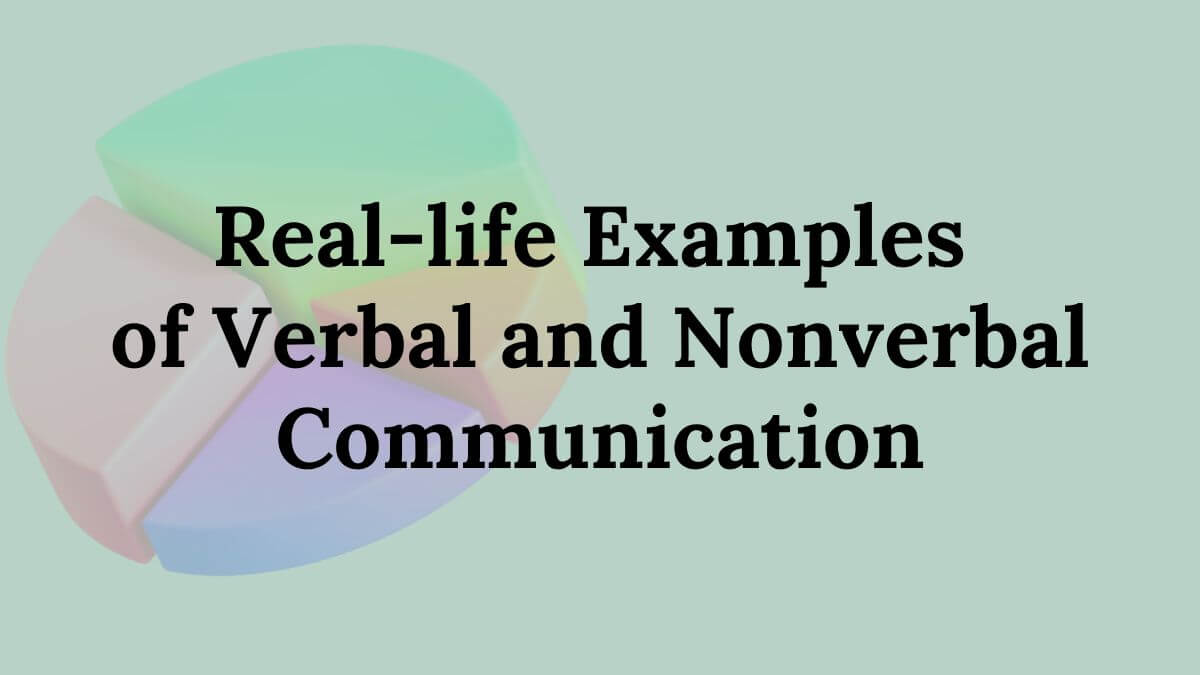Discover 12 real-life examples of verbal communication and nonverbal communication to improve your English skills and understand human interaction better.
Communication is the foundation of human interaction, and it comes in many forms. From the words we speak to the gestures we make, both verbal and nonverbal communication play crucial roles in conveying messages effectively. Understanding these two types of communication can not only enhance your English skills but also help you interact more confidently in everyday life. In this blog post, we will explore 12 real-life examples of verbal communication and nonverbal communication, providing clear explanations and practical insights for English learners and educators alike.
What is Verbal Communication?
Verbal communication is the use of words-either spoken or written-to express thoughts, ideas, and feelings. It is the most direct form of communication and allows us to share information clearly and precisely. In English learning, verbal communication helps learners practice pronunciation, sentence structure, and vocabulary.
Key Features of Verbal Communication
- Clarity: Words help convey ideas precisely.
- Formality Levels: Depending on the context, you can use formal or informal language.
- Interactive: Allows for immediate feedback through conversations.
Real-Life Examples of Verbal Communication
- Classroom Discussions
In a classroom setting, teachers explain lessons using words, and students respond to questions verbally. This not only strengthens understanding but also improves speaking and listening skills. - Team Meetings at Work
Professionals use verbal communication to share updates, give instructions, and discuss strategies. Clear verbal communication ensures smooth collaboration and prevents misunderstandings. - Phone Conversations
Talking on the phone is a common verbal communication method. Tone, word choice, and clarity are vital to convey the right message when body language isn’t visible. - Public Speaking
Speeches, presentations, and lectures rely entirely on verbal communication to inform, persuade, or entertain an audience. Proper use of words can significantly impact how the message is received. - Storytelling
Whether it’s a teacher telling a story to children or a friend narrating an experience, storytelling is a verbal communication tool that engages listeners and conveys emotions effectively. - Emails and Text Messages
Written verbal communication is just as important as spoken communication. Emailing or messaging requires clarity, correct grammar, and proper vocabulary to avoid misinterpretation.
Verbal Communication and NonVerbal Communication in Daily Life
Communication is an essential part of our everyday lives. Verbal communication and NonVerbal Communication work together to help us express thoughts, emotions, and ideas clearly. While verbal communication uses words—spoken or written—nonverbal communication relies on gestures, facial expressions, posture, and tone of voice to convey meaning. Understanding both types is key to effective interaction in personal, educational, and professional settings.
What is Nonverbal Communication?
What is Nonverbal Communication?
Verbal communication and NonVerbal Communication are both key components of effective human interaction. Nonverbal communication is the transmission of messages without using words. It involves body language, facial expressions, gestures, posture, tone, and even eye contact.
In daily life, verbal communication and NonVerbal Communication often work together to convey meaning more clearly. For example, a friendly smile while speaking shows warmth, and a confident posture reinforces your spoken message.
By understanding verbal communication and NonVerbal Communication, you can interpret others’ emotions better, respond appropriately, and make your own messages more effective and engaging.
Key Features of Nonverbal Communication
- Body Language: Includes gestures, posture, and facial expressions.
- Tone of Voice: Pitch, speed, and volume can change the meaning of spoken words.
- Contextual Signals: Cultural norms often affect how nonverbal cues are interpreted.
Real-Life Examples of Nonverbal Communication
- Facial Expressions
A smile can express friendliness, while a frown might indicate disapproval or confusion. Facial expressions are universal cues that can enhance verbal communication or even replace words. - Gestures
Hand signals, nodding, or waving are gestures that convey messages without speaking. For example, a thumbs-up signifies approval or agreement in many cultures. - Eye Contact
Maintaining eye contact shows attentiveness and confidence, while avoiding eye contact might indicate shyness or discomfort. - Posture
Standing or sitting upright demonstrates confidence and engagement, whereas slouching can signal disinterest or fatigue. - Tone and Volume of Voice
Even in verbal communication, tone and volume are nonverbal cues. A loud voice may show excitement or anger, while a soft tone can indicate calmness or empathy. - Proxemics (Personal Space)
The distance between individuals during interactions communicates comfort levels, respect, or intimacy. For example, standing too close might make someone uncomfortable, while keeping an appropriate distance fosters a positive environment.
Why Understanding Both Types of Communication Matters
Mastering both verbal and nonverbal communication is essential for effective interaction. In English learning, this means practicing speaking, listening, and understanding body language simultaneously. Educators can also leverage these methods to make lessons more engaging and relatable.
Tips to Improve Verbal and Nonverbal Communication
- Practice Speaking Daily: Engage in conversations with peers or teachers to improve fluency.
- Observe Nonverbal Cues: Pay attention to gestures, expressions, and posture to better understand context.
- Record and Review: Recording your speaking practice helps identify areas for improvement in tone and clarity.
- Use Role-Playing: Simulate real-life scenarios to practice both verbal and nonverbal communication.
- Learn Cultural Differences: Different cultures interpret gestures and expressions differently, so awareness is crucial.
Understanding Verbal Communication
Verbal communication and NonVerbal Communication are both essential for effective interaction. Verbal communication is the use of words—spoken or written—to convey ideas, thoughts, feelings, or information. It is the most direct and widely used form of communication in our daily lives.
Whether you are talking to a friend, sending a message, or giving a presentation, verbal communication and NonVerbal Communication play a crucial role in expressing yourself clearly and ensuring your message is understood.
In addition to words, verbal communication and NonVerbal Communication work together to strengthen your message. For example, speaking politely while maintaining eye contact demonstrates confidence and respect. Similarly, tone, pace, and clarity in speech enhance understanding, showing how verbal and nonverbal cues complement each other.
Mastering verbal communication and NonVerbal Communication helps improve relationships, build confidence, and make interactions more meaningful, whether in personal, educational, or professional settings.
Key Features of Verbal Communication
- Clarity and Precision: Verbal communication allows you to express ideas in a clear and precise manner. Using the right words helps avoid confusion and ensures that your message is understood correctly.
- Interactive Nature: Unlike written notes or texts, verbal communication often allows immediate feedback, making conversations more dynamic and engaging.
- Adaptable Style: Depending on the situation, verbal communication can be formal or informal. For example, the way you speak in a job interview is different from chatting with friends.
Types of Verbal Communication
- Oral Communication: This includes face-to-face conversations, phone calls, video calls, meetings, and speeches. It relies heavily on tone, pronunciation, and clarity.
- Written Communication: This includes emails, letters, reports, messages, and social media posts. Proper grammar, punctuation, and vocabulary are key to effective written communication.
Real-Life Examples
- Classroom Discussions: Students and teachers exchange ideas, ask questions, and share knowledge through spoken words.
- Workplace Meetings: Team members communicate updates, strategies, and feedback verbally to ensure smooth collaboration.
- Phone Conversations: When body language isn’t visible, tone and choice of words become extremely important in conveying the right message.
Benefits of Mastering Verbal Communication
- Improves Relationships: Clear verbal communication reduces misunderstandings and strengthens personal and professional relationships.
- Boosts Confidence: Being able to express your thoughts clearly makes you more confident in social and work environments.
- Enhances Learning: For English learners, practicing verbal communication improves pronunciation, vocabulary, and sentence structure.
By understanding verbal communication, you can express yourself effectively and ensure that your message reaches others as intended. Combining this with nonverbal communication further strengthens your overall communication skills.
Read More:
Understanding NonVerbal Communication
Verbal communication and NonVerbal Communication are both essential parts of human interaction. While verbal communication uses words, verbal communication and NonVerbal Communication together allow us to convey messages more clearly and effectively.
Nonverbal communication is the process of conveying messages without using words. Instead of spoken or written language, it relies on body language, facial expressions, gestures, posture, eye contact, and even tone of voice. By combining verbal communication and NonVerbal Communication, we can express emotions, attitudes, and ideas more accurately.
For example, smiling while speaking shows friendliness, while maintaining eye contact demonstrates confidence. These are practical ways verbal communication and NonVerbal Communication work together in daily life to make interactions meaningful and clear.
Key Features of NonVerbal Communication
- Body Language: Movements, gestures, and posture can express confidence, openness, nervousness, or disagreement without speaking a single word.
- Facial Expressions: Smiles, frowns, raised eyebrows, and other expressions convey emotions like happiness, confusion, anger, or surprise.
- Tone and Voice: The way words are spoken—speed, pitch, volume, and intonation—adds meaning beyond the words themselves.
- Proxemics (Personal Space): The distance we maintain while interacting communicates comfort, intimacy, or formality.
- Eye Contact: Maintaining eye contact shows attentiveness and confidence, while avoiding it may indicate discomfort or disinterest.
Types of NonVerbal Communication
- Kinesics: Refers to body movements, gestures, facial expressions, and posture that communicate messages.
- Paralanguage: Includes tone, pitch, volume, and speaking speed, which provide context to verbal communication.
- Proxemics: The use of personal space in interactions to express familiarity, respect, or authority.
- Haptics: Communication through touch, such as handshakes, hugs, or pats on the back.
- Appearance and Artifacts: Clothing, hairstyle, and accessories can convey personality, professionalism, or cultural identity.
Real-Life Examples
- Smiling: Indicates friendliness or agreement, even without words.
- Nodding: Shows understanding or approval during conversations.
- Crossed Arms: Can signal defensiveness or discomfort.
- Tone Variation: Speaking softly to comfort someone or loudly to emphasize a point.
- Distance in Interaction: Standing too close may seem aggressive, while maintaining appropriate distance shows respect.
Benefits of NonVerbal Communication
Enhances Verbal Communication: Nonverbal cues support and clarify spoken words, making messages more impactful.
Builds Better Relationships: Understanding others’ body language helps respond appropriately and build trust.
Expresses Emotions Clearly: Nonverbal communication often conveys emotions that words cannot fully express.
By mastering nonverbal communication alongside verbal skills, you can interact more effectively, understand others better, and convey your messages with greater clarity and confidence.
Conclusion
Verbal communication and NonVerbal Communication are intertwined in almost every interaction we have. By observing, practicing, and understanding these forms, English learners can use verbal communication and NonVerbal Communication more effectively to build stronger relationships and gain confidence in both personal and professional settings.
From classroom discussions to subtle gestures, the examples above highlight the importance of combining words with actions for meaningful and clear communication. Mastering verbal communication and NonVerbal Communication isn’t just about choosing the right words-it’s about expressing yourself in ways others can understand, feel, and connect with.
Keep practicing both verbal communication and NonVerbal Communication every day, and you will notice a remarkable improvement in your English skills and overall confidence.

